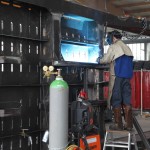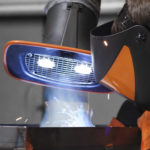Nitrous gases in welding fumes What dangers are faced when welding
Nitrous gases are often responsible for acute poisoning when welding. They occur during gas welding and arc welding processes. Due to current occupational medicine findings, the occupational exposure limits for nitrous gases were significantly lowered in May 2016.
The term nitrous gases or nitrogen oxides (NOx) describes a mixture of nitrogen monoxide and nitrogen dioxide. Nitrogen monoxide occurs when welding at the edge of a flame or arc at temperatures of more than 1,000°C from the oxygen and nitrogen in the air. The nitrogen monoxide then oxidizes to nitrogen dioxide at room temperature. Depending on welding or cutting processes and workplace conditions, nitrous gases are generated in varying quantities and composition.
The workplace limit value is 2 ppm (parts per million) for nitrogen monoxide, which converts to about 2.5 mg/m³. For nitrogen dioxide it is even lower at 0.5 ppm (0.95 mg/m³). These values apply to persons with exposure to hazardous substances and are based on 8 hours/day and 40 hours per week. For comparison: In Europe, the 1 hour limit value for nitrogen oxides is 0.2 mg/m³ outside of workplaces. This must not be exceeded more than 18 times within one year. The annual limit value is 0.04 mg/m³.
Nitrous gases: Poisoning and lung damage
Nitrous gases are toxic and in higher concentrations, they can be detected by an acrid, pungent, chlorine-like odor. They have an effect on the lower respiratory tract and lungs once breathed in. Nitrous gases cause damage to the mucous membranes, the upper and lower respiratory tract and lung tissue. The symptoms of nitrous gas poisoning include: Trouble breathing, vomiting, anxiety and feeling of suffocation as well as a pale bluish discoloration of the skin. In higher concentration, nitrous gases may lead to a pulmonary edema, which can sometimes be fatal. Even if a pulmonary edema is healed, consequential damage such as chronic bronchitis or respiratory diseases may remain.
The extent to which welders are at risk from nitrous gases depends on the size of the flame or arc, since the oxidation occurs on the edge of the atmospheric nitrogen. Thus, particularly high emissions occur during oxyfuel welding such as gas welding, heating, gouging or flame cutting as well as plasma cutting. Nitrous gases also occur during arc welding process, albeit in relatively smaller amounts. The health risk increases if these processes are carried out in unfavorable working positions or small and insufficiently ventilated rooms.
Extract nitrous gases at source
Companies should pay attention to certain procedural and workplace-specific factors to ensure that nitrous gases are released in quantities that are as low as possible. These include amongst others:
- Smaller burner sizes and flame lengths,
- Avoiding free-burning flames or
- A small distance between burner and workpiece.
These measures alone however do not provide adequate protection against hazards. Nitrous gases should thus be captured by welding fumes extraction at the source. This reduces the concentration in the breathing zone of the welder effectively. Even if there is no effective extraction of nitrous gases in the devices and plants, the concentration is still drastically reduced when mixed with ambient air. A further dilution occurs by the mandatory required proportion of outside air in the supply air.
Since nitrous gases can not be filtered out effectively with conventional activated carbon filters, it is recommended that the extracted air from highly NOx-emitting processes is lead outside once the fumes have been filtered out. In winter, it is possible to preheat the replacement outside air using heat recovery.
Furthermore, the ventilation facilities have to be arranged in such a way that the welders work in the supply air stream. If extraction or room ventilation is not possible in particularly confined spaces, then suitable breathing masks have to be worn. These should be independent from the atmosphere, such as, for example fresh air breathing apparatus. Welding helmets with compressed air supply may also be necessary in confined spaces.





